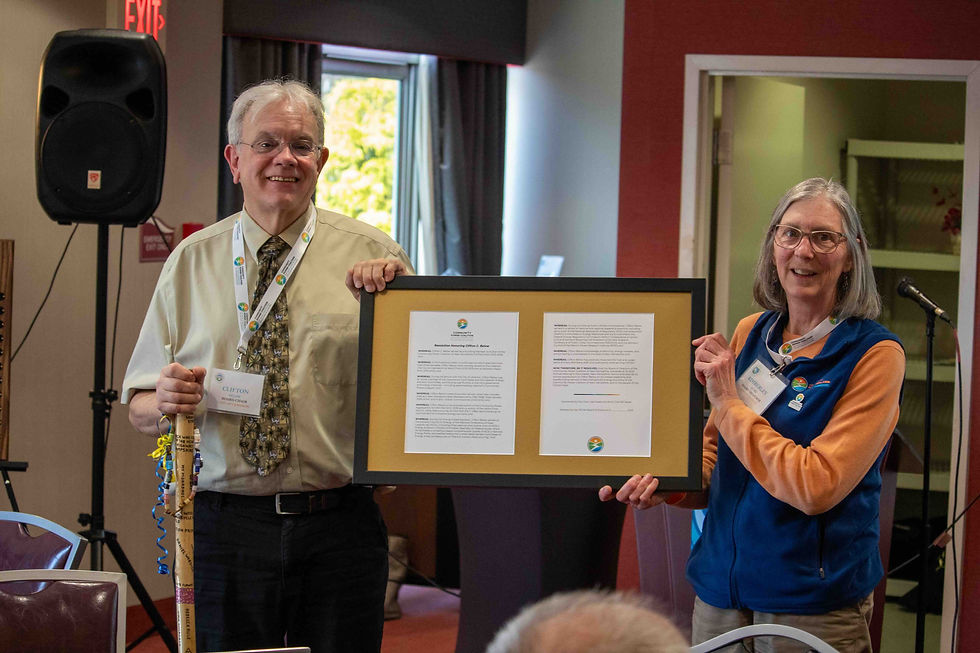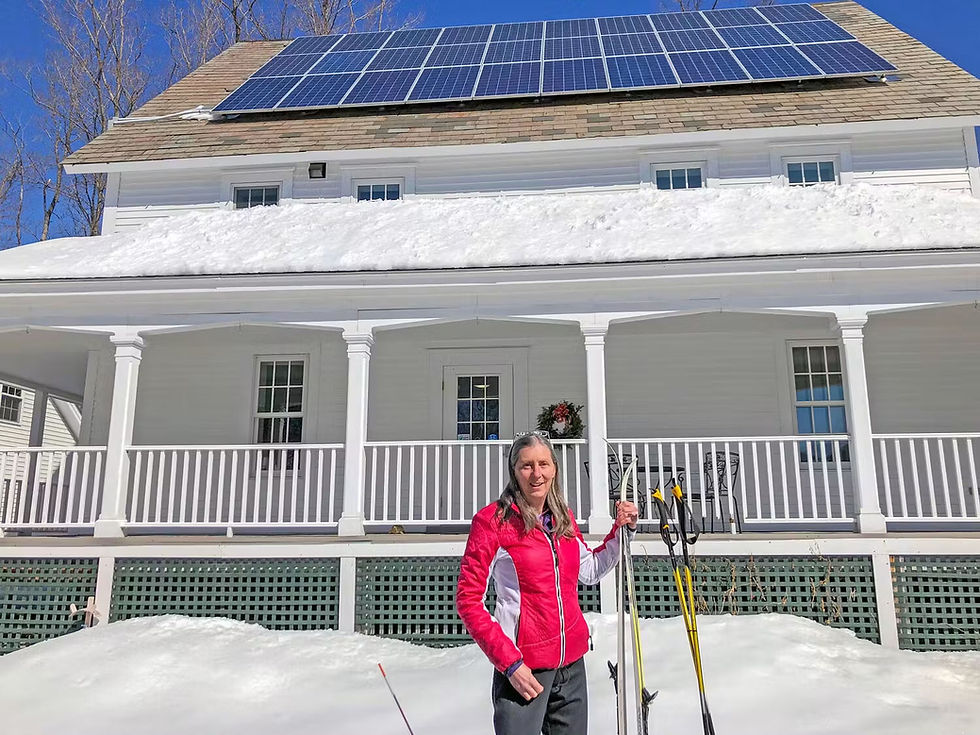Charged Up: Meet Kimberley Quirk
- Jul 24
- 6 min read
Updated: Jul 29
From Zero-Net Energy to Statewide Strategy: Kim Quirk’s Role as CPCNH Board Chair

CPCNH Board Chair Kim Quirk didn’t just study energy—she built a life around it. With a master’s degree in electrical engineering from Dartmouth’s Thayer School of Engineering and a background in Boston’s high-tech and entrepreneurial circles, she redirected her career to focus on climate solutions. In 2009, she launched a solar installation company and renovated a historic 1850s home into a zero-net-energy building—installing solar PV, hot water, battery backup, and a seasonal thermal storage tank. The hands-on project earned her a “Lean & Green” Award from NH Business Magazine in 2012.
Today, she works as a Commercial Storage Designer and Analyst at ReVision Energy, designing battery systems for Commercial, Industrial, and Municipal buildings and emergency shelters. Elected Chair of the Board of CPCNH during the 2025 Annual Meeting, Kim brings decades of technical, business, and civic leadership to the role. She previously served three years as Treasurer and helped shape the work of CPCNH’s Risk Management and Finance Committees. Representing Enfield on the CPCNH Board, she co-founded the Enfield Community Power Committee with fellow representative Jo-Ellen Courtney. As Chair, Kim is focused on scaling CPCNH’s impact, supporting local communities, and championing energy self-determination across the state.
What inspired you to take on the role of Board Chair at CPCNH?

Kim Quirk: I’ve been involved with CPCNH since the beginning, both as Enfield’s representative and as a board member. Over the past few years, I’ve served as Treasurer and been part of our financial oversight process. When the opportunity to run for Chair came up, I saw it as a chance to help support the next phase of CPCNH’s development. We’re growing, we’re serving more communities, and we have an opportunity to become a long-term leader in New Hampshire’s energy landscape. I want to help ensure that CPCNH stays financially strong and continues to reflect the voices of its member communities.
What excites you most about Community Power as a model for energy transformation?
KQ: Community Power is fundamentally about local choice and equity. It gives communities control over their energy future and makes it possible for people who might not have access to rooftop solar or the capital to invest in clean energy—like renters, low-income residents, or people living in multifamily housing—to benefit from renewables. That’s what really drew me in. I believe that by working together as a coalition, we can create programs that benefit everyone, not just a select few.
What are some of your goals as Chair for the next year?

KQ: I want to focus on strengthening our financial policies and reserves. We’ve built a solid foundation, but as we grow and serve more customers, we need to think long-term. That means refining our governance structures, preparing for different market scenarios, and supporting new communities as they join. I also think it’s important to make sure the board is welcoming, transparent, and inclusive. We have a diverse group of representatives from around the state, and I want to make sure every voice is heard.
I also see CPCNH as a key player in helping communities take more control over their energy future. That means offering new programs, building trust, and providing stable services that investor-owned utilities might not offer. As Chair, I want to help the organization scale responsibly and sustainably—so that it remains a valuable energy partner for the long term.
How has your background in engineering and business informed your leadership style?
KQ: My engineering background gives me a way to evaluate complex systems and understand how different pieces interact—that’s been really helpful in thinking through CPCNH’s power resources operations and market strategy. My business background, especially running my own businesses, provided invaluable experience in leadership, communications, navigating challenges and finding practical solutions. I try to bring business experience, a technical mindset and a collaborative approach to the board. I think it helps to be able to translate complex issues into ideas that people from different backgrounds can engage with.
What lessons from your work in Enfield do you bring to the boardroom?
KQ: Enfield was one of the early adopters of Community Power, and we put a lot of time into engaging residents and building trust. We hosted public meetings, created educational materials, and made sure people had opportunities to ask questions. That kind of engagement takes time, but it’s worth it. Working alongside Jo-Ellen Courtney and others in our community, we were able to help people understand the benefits and feel confident in the decision. That approach—community-driven and transparent—is something I try to bring into my role at CPCNH.
Tell us a bit about your work with ReVision Energy.
KQ: I am an Electrical Engineer designing solar and battery storage systems for residential, commercial and municipal customers. That includes analyzing a building’s consumption data, sizing the solar array and storage system and providing financial analysis to optimize the customer’s return on investment. Some of the systems I work on are focused on reducing demand charges on the electric bill or meeting the requirements of a demand response program, and other systems are designed for resiliency to back up building loads during a power outage. It ties directly into the work we’re doing at CPCNH—finding ways to make our energy systems more renewable, resilient, local, and sustainable.
What innovations in solar and storage are you most excited about?
KQ: There’s so much happening in the energy storage space right now. We’re seeing new battery chemistries, better controls, and more opportunities to interact with the grid, with our EVs, and our homes in smart ways. What excites me is the potential for distributed storage to help communities manage their energy use more effectively and reduce stress on the grid. When we combine that with Community Power, we have a real opportunity to rethink how we generate and consume energy and how we can use distributed resources, at people’s homes, to help us scale to all electric homes.
What do you see as the biggest opportunities or challenges in New Hampshire’s energy landscape?
KQ: One big challenge is the structure of our current utility model—it wasn’t designed to support innovation at the local level. There are also real affordability concerns, especially with rising energy prices. I think CPCNH has a role to play in addressing both of those issues. We can offer innovative rate structures, support local generation, and provide services that investor-owned utilities can’t or won’t prioritize. But we also need to be careful and strategic—and that’s where governance and financial planning become so important.
What has been one of your proudest moments in your energy journey?

KQ: Renovating my 1850s house into a zero-net-energy home was a huge milestone. It was an experiment in sustainability and problem-solving, and I did much of the work myself—installing a solar hot water system, building a seasonal thermal storage tank, adding super-insulation, and incorporating Zero Energy design principles. The house runs entirely on solar electricity with battery backup, and it has no fossil fuels or combustion systems – no emissions. That project showed me just what was achievable with the energy efficient and renewable products available at that time and gave me the confidence to help hundreds of other homeowners in the Upper Valley go solar and reduce their use of fossil fuels.

When I first started looking into solar for my own home, I realized how hard it was to find someone locally who really understood the technology and could explain it clearly. That gap is what motivated me to start Energy Emporium. Launching my own solar company, growing it, and eventually merging with ReVision was also deeply fulfilling. Both projects taught me that the path to clean energy can start right at home—and ripple outward into community and policy change.
When you’re not thinking about energy, where can we find you?
KQ: I love biking and kayaking, especially on Grafton Pond. I also enjoy playing music with various groups in the area, as well as fiber arts, knitting, quilting—these creative outlets help me recharge. Spending time outdoors is really important to me. It keeps me grounded and reminds me why this work matters.
From renovating a historic home into a model of energy independence to helping shape the future of municipal energy programs, Kim Quirk continues to bring vision and grounded leadership to every challenge she tackles. As CPCNH Board Chair, she remains focused on equity, sustainability, and the power of community-led solutions to transform how we generate and use energy across New Hampshire.
Check out the latest CPCNH News at cpcnh.org/news






Comments